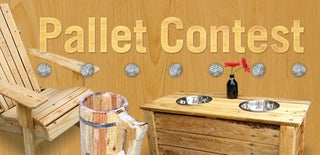Introduction: Pallet Treasure Chest
I have access to many pallets and pallets straps at work, so I wanted to make use of some of these besides for firewood :)
So I decided to make a chest for storing valuable keepsakes.
I hope you enjoy this instructable, and if you have any questions - fire away.
Please Remember to Vote for me in the Contest. Thank you.
Step 1: Get the Basic Shape
To start your Pallet Treasure Chest, you will need to gather some pallet boards, or what I found were pieces of strapping-like wood used as spacers between rolls of roofing material. I used these because I wanted to avoid any nail holes in the donor wood.
You will also need three pieces of 1"x12" pine board which will be used to create the side profile and serve as the base of the chest in hopes that it will be strong enough to support a little weight inside.
Other Materials required to build as pictured;
- Antique Brass Handles, these are regular drawer handles purchased on ebay.
- Antique Brass Latch, this was a decorative latch that allows use of a small padlock.
-Antique Brass Corners, for the bottom to avoid damage.
- Antique Brass (you guessed it) Hinges, bought at a local hardware store.
- Strips of Leather ( or in my case *faux* leather 120cm x 12mm)
- Small Brass Tacks, used to attach the straps to the Chest.
Step 2: Attach Pallet Boards
Once you've determined the height you want to use, you will need to cut the Pine to shape and also cut the radius at the top. I used a fairly tight radius to give it a Pirate Chest look, but you could use a larger radius to suit whichever style of chest you desire.
Use a jigsaw or scrollsaw or whatever tool you choose to cut one board and use it on the other to ensure both boards will be marginally the same. If you have access to higher level tools you may cut them both together. Whatever gets the job done, it will be a rustic piece, remember :)
Attach the two side profile pieces to the base by using wood glue and a brad nailer.
Then you must get the pallet wood ready for use, cutting them to width to fit onto the sides.
This one is 18" wide, so cut all the pallet wood to this length.
Using a brad nailer, attach the cut and sanded boards to the sides. You may also use wood glue here before this, smear the wood glue around smooth before setting them into place.
I used the same pallet pieces cut into two for the top pieces, as well.
In order for these pieces to sit flush to one another, I used a benchtop sander/shaper to sand 15 degrees off each piece so that the edges will be flush together.
Use wood glue once again to pre-attach the pieces and then a brad nailer to keep them into place.
Once you have enough pieces into place to wrap the entire circumference you can then sand off any of the rough edges.
The last step here is to sever the sides to reveal where the chest will open. I used a jig saw and made a plunge cut into to the side to try to minimize any damage to the front pallet pieces.
Now that you have revealed the inside of the chest, a liberal use of wood glue on some or all of the joints will make the chest that much stronger.
The last step in this portion is to sand, stain and clear coat the Chest to make sure it will last for many years to come. (You may notice that there is a small latch that I picked up from a local hardware store that I thought looked too small so bought the larger, more decorative one).
Step 3: Installing Hardware
Now that the sealer has dried on the chest, we can now start attaching the hardware.
Measure the handles so that they are centered and mark the holes with a pencil or a nail punch.
Make sure to drill pilot holes before screwing them on to avoid cracking the wood.
Attach both handles with the screws provided in the the package.
Now we can install the latch on the front, onto the top and bottom sections.
Lay them both down on the joint together and mark their screw holes with a pencil or a nail punch.
Pre-drill the holes and screw them into place.
Step 4: Leather-ish Strap
The next step is attaching the leather strap using the brass tacks. Measure where you want it to be, both pieces equally distanced from the side.
Now you can use the brass tacks and a hammer to tap them into the strap and wood. I found out as I got further into this that using a pair of needle-nose pliers to hold the tack made it easier to get them in straight.
Stretch the strap to fit to each edge, that way you can work towards the other side with the tacks and still keep the strap tight. Once each edge has been tacked, fill in towards the center. I put two tacks in each pallet strap close to the edges . Once I got to the top, I fastened a tack every second board due to their narrower size.
Cut off the excess strap and the strap where the lid sits using a razor blade.
It`s now time to make the inside ready for use by putting in red felt picked up at Michael`s Arts and Crafts.
I started with round top sections, and placed the felt on the outside flush to the bottom of the lid and using a sharpie, and put dots around the edge to make a pretty accurate curve of the inside.
Cut the felt and test fit, you may need to trim to fit. The felt may also stretch a little when fitting it into place so you might want to try and account for that as well. Using spray adhesive, apply a pretty generous amount and allow it to tack for several minutes before putting the felt into place.
Moving on to the top curved section, cut enough material to fit this and the smaller sections of the front and back of the lid too. Use the spray adhesive, and attach.
Much the same way for the rest of the interior. I found this one of the more challenging parts of this project.
Step 5:
Now that the interior has been fitted, I used the excess pieces of strap that I had left over, stapled them together and using the brass tacks again, attached it to the interior to make a ``stay``.
Your chest is now completed and you can fill it with the many treasures that will last your lifetime. Thank you for reading my instructable, I hope it helps you with your own projects, and I would like to see your results.

Runner Up in the
Vintage Contest

Participated in the
Pallet Contest

Participated in the
Glue Contest

Participated in the
Epilog Challenge VI













